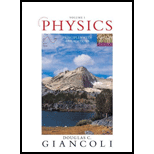
The dipole moment, considered as a vector, points from the negative to the positive charge. The water molecule. Fig. 17-42 e has a dipole moment which

Figure 17-42
Want to see the full answer?
Check out a sample textbook solution
Chapter 17 Solutions
Physics: Principles with Applications
- (a) Find the electric field at the center of the triangular configuration of charges in Figure 18-54., given that qa=+ 2.50 nC, qb=-8.00 nC, and qc=+ 1.50 nC. (b) Is there any combination of charges, other than qa= qb=qc,that will produce a zero strength electric field at the center of the triangular configuration?arrow_forwardA water molecule consists of two hydrogen atoms bonded with one oxygen atom. The bond angle between the two hydrogen atoms is 104( (see below). Calculate the net dipole moment of a water molecule that is placed in a uniform, horizontal electric field of magnitude 2.3108N/C . (You are missing some information for solving this problem; you will need to determine what information you need, and look it up.)arrow_forwardSuppose a speck of dust in an electrostatic precipitator has 1.00001012 protons in it and has a net charge of 5.00 nC (a very large charge for a small speck). How many electrons does it have?arrow_forward
- Two small spheres separated by a distance equal to 20.0 cm have equal charges. How many excess electrons must be present in each sphere so that the modulus of the repulsion force between them is equal to 3.33x10-21N?arrow_forwardHow much electric force (in N) exist between two electron separated by a distance of 5.0 x 10-15 m? The answer (in fundamental SI unit) is ___________ (type the numeric value only)arrow_forwardDipole consisting of two equal but opposite point charges separated by a distance "2L". The magnitude either dipole charge is , "qd". A vector quantity called the Electric Dipole Moment Vector ,p ,is defined to have a magnitude p = (qd)(d) (d= separation distance of the dipole charges) and a unit vector direction pointing from negative to positve charge Find the dipole moment vector “p”arrow_forward
- In a hydrogen atom, the electron (q= -1.60 x 10^-19 C) is 5.29 x 10^-11m away from the proton of equal charge magnitude, but opposite sign (q= 1.60 x 10^-19). Find the electrical force of attraction. Be sure to properly include the units in each step.arrow_forwardTwo uncharged, conducting spheres are separated by a distance d. When charge -Q is moved from sphere A to sphere B, the Coulomb force between them has magnitude F0. (a) Is the Coulomb force attractive or repulsive? (b) If an additional charge -Q is moved from A to B, what is the ratio of the new Coulomb force to the original Coulomb force, Fnew /F0? (c) If sphere B is neutralized so it has no net charge, what is the ratio of the new to the original Coulomb force, Fnew /F0?arrow_forwardTwo fixed point charges +4e and +9e units are separated by a distance x. Where should a third point charge to be placed for it to be in equilibrium?arrow_forward
- Science fiction author Larry Niven hypothesized a device that could neutralize the electric charge on the electrons in a object. When this happened, the mutual repulsion between the protons would rip the object apart on an atomic level, but rather than being instantaneous, the process took several seconds to take full effect.Suppose that this device is used on a 20.0-g block of lead, which is held rigidly fixed in place. The device neutralizes the charge of 2.3% of the electrons. Before the lead block rips itself apart, it is put into contact with a 20.0-g lead bullet which is initially uncharged. The bullet immediately contributes enough electrons to the block that the charges on the block and bullet are equal, and then the force of electrostatic repulsion launches the bullet. What is the charge on the bullet just before it launches? Assume that lead has an an atomic mass of 207.2 g/mol, and there are 82 electrons in a lead atom. -9300 C 8800 C 9300 C -8800 C 5.48 x 1022 Carrow_forwardA point charge, q = -5.0 nC, and m = 2.0 x 10-18 kg, is shot vertically upward with an initial speed of 3.0 x 105 m/s from a thin, infinite, planar sheet of uniform charge with surface charge density of σ = +4.0 nC/m^2 . To what vertical elevation will q rise above the sheet of charge? Neglect gravityarrow_forwardTwo hard rubber spheres, each of mass m = 15.0 g, are rubbed with fur on a dry day and are then suspended with two insulating strings of length L = 5.00 cm whose support points are a distance d = 3.00 cm from each other as shown. During the rubbing process, one sphere receives exactly twice the charge of the other. They are observed to hang at equilibrium, each at an angle of θ = 10.0° with the vertical. Find the amount of charge on each sphere.arrow_forward
 Physics for Scientists and Engineers: Foundations...PhysicsISBN:9781133939146Author:Katz, Debora M.Publisher:Cengage Learning
Physics for Scientists and Engineers: Foundations...PhysicsISBN:9781133939146Author:Katz, Debora M.Publisher:Cengage Learning College PhysicsPhysicsISBN:9781938168000Author:Paul Peter Urone, Roger HinrichsPublisher:OpenStax College
College PhysicsPhysicsISBN:9781938168000Author:Paul Peter Urone, Roger HinrichsPublisher:OpenStax College


